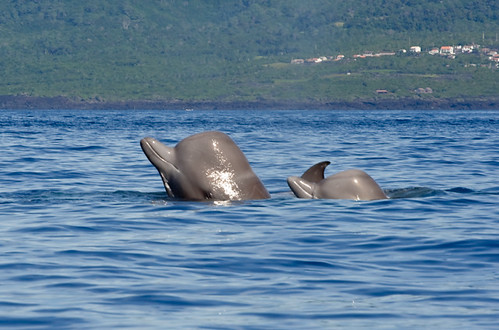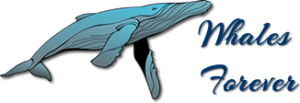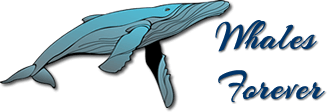Scientific Name: Hyperoodon ampullatus
Other Names: Steephead, North Atlantic Bottlenosed Whale, Flathead, Bottlehead
The Northern Bottlenose Whale is distinctive for its colouring and characteristic beak shape. Because it is curious and will easily approach boats, usually attracted by the noise of the engine, many of these whales were victims of whale hunters before 1977, when it became a protected species. Another endangering factor was this whale’s determination to stay with a wounded companion, meaning that, once one had been injured, more would follow and would become easy prey to whalers.

Northern Bottlenose Whale having a look around on the surface.
Physical Characteristics.
The colour of this whale’s long, stocky, cylindrical body is a characteristically brown, grey-brown or grey colour with lighter shades on the belly. There are often grey markings on the body, as well as scars and scratches.
The forehead is exceptionally bulbous, perhaps even hanging over the beak. Two to four little teeth are found in the bottom jaw. In males, they erupt, even when the mouth is closed. In females, they stay beneath the surface of the gum, proving completely useless to the animal.
The small, pointy dorsal fin is situated far behind the centre of the body and might be of a darker shade than the rest of the body. The small pectoral flippers are also pointed and are situated very close to the head of the animal. The tail fin, also known as a fluke, is broad, with concave trailing edges and a bit of an outward bulge in the centre, as opposed to a notch.
When fully grown, the Northern Bottlenose Whale is about seven to nine metres long, and will weigh between 5.8 and 7.5 tonnes.
Behaviour
A curious whale, this species is keen to approach boats and investigate foreign sounds.
It is believed to dive to great depths, staying under the water’s surface for up to 70 minutes. When it is at the water’s surface, it may stay there for about 10 minutes, curious to see any activity.
Sadly, these whales are known to breach.
Where to Find Them
The Northern Bottlenose Dolphin is found in the North Atlantic Ocean, both on the coast of the countries that flank this sea as well as in the deep waters between them. Usually, they live beyond the continental shelf, preferring the depths beyond.
Diet
This whale will dine on squid, small fish and other invertebrates (such as starfish). Even in males, its teeth are not designed for hunting, grasping and chewing, so they are more adept at tearing and swallowing bigger hunks of meat.
Threats
The Northern Bottlenose Whale is threatened mainly by human interference and poisonous pollution that is released into its watery home and the air that it breathes.
For more information, please go here: http://marinebio.orgNorthern Bottlenose Whale

